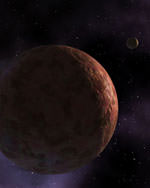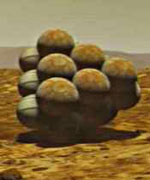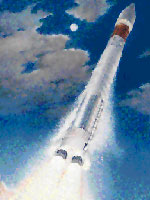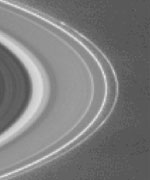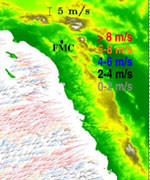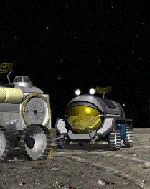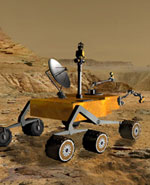
Image credit: NASA/JPL
Since their arrivals on Mars, our two robotic wanderers have sent us incredible images and data from one of our nearest neighbors in the Solar System. The primary science objective of the Mars Exploration Rovers (MERs) is to determine to what degree the past action of liquid water on Mars has influenced the Red Planet’s environment over time.
While there is no direct evidence of liquid water on the surface of Mars today, the record of past water activity on Mars can be found in the rocks, minerals, and geologic landforms, particularly in some specific, diagnostic features that we believe form only in the presence of water. That is why both MERs are equipped with special tools to enable them to study a diverse collection of rocks and soils that may hold clues to past water activity on Mars and determine whether the planet ever had the potential to harbor life in the long-distant past, or, much less likely, today.
The information that NASA has gleaned in just the short amount of time that Spirit and Opportunity have been on the surface of Mars has been incredibly revealing. We have images that show rocks and surface structures in unprecedented detail. We are seeing a side of Mars that is vastly different from what we have encountered during past missions, because we targeted these special rovers to explore places that we knew would be compelling.
While we are incredibly pleased with the data and images we have obtained thus far and look forward to many more, we must not forget that traveling to and exploring Mars is a very challenging endeavor. As I have said many times before – both here on Capitol Hill and in the press – Mars is an extremely exciting and compelling Solar System destination, but it is also an incredibly difficult target, as history has often proven.
The landing and subsequent rollout of the two Rovers were practically picture perfect, which is a daunting engineering feat in and of itself, and one which makes me proud of NASA’s talented and capable Mars team. However, lest we became too confident about our Mars conquest, we were reminded of the significant challenges that operating on the Red Planet entails when the Spirit rover presented the Mars team with a serious technical challenge.
Spirit touched down in an area of Mars known as the Gusev Crater on January 4, 2004. After eighteen days of nearly flawless operation and after returning significant scientific data, including striking pictures of distant hills – and a rock affectionately dubbed “Adirondack ” – the Spirit rover developed an apparent communications problem that initially baffled the entire Mars team. In the ensuing days, Spirit sent us intermittent signals, and we sent the spacecraft numerous queries to try to diagnose the exact nature of the problem.
We were able to determine that the problem was related to software, and the team at JPL developed the necessary procedures and protocols to get Spirit back in business. Had Spirit’s communication problem been a hardware issue, we would be in much more dire straits for obvious reasons. Spirit is now performing as it was intended and continuing to explore its Martian surroundings.
Having actual data transmissions from Spirit’s descent to the Martian surface also provided significant benefits for the team planning the landing of the second Mars rover, Opportunity. Actual descent data from the first spacecraft were used to confirm our models of the behavior of the Martian atmosphere and weather – models which we depended on to plan Opportunity’s descent. The data from Spirit indicated that, while the descent was within the predicted limits of our engineering model, it was close to edge of the anticipated margins.
Armed with this new knowledge, NASA opted to open Opportunity’s parachute earlier to provide for a slower descent and a more gentle arrival on the Red Planet. On January 25, 2004, Opportunity bounced onto the opposite side of Mars – in an area called Meridiani Planum – from where its twin had landed.
The new landing location was “a world away ” from Gusev Crater in more ways than just distance. The initial images transmitted later that day fascinated the science team, revealing an area of dark soil and possible bedrock – a feature we have long searched for but never seen before on any planet’s surface – interspersed with patches of the more familiar red Martian soil. This region of Mars particularly interested planetary geologists because they believed it may contain abundant deposits of hematite, a mineral that, when found on Earth, has usually formed in the presence of persistent liquid water. We now know that their suspicions were correct.
On March 2, 2004, NASA announced that the Opportunity rover had found strong evidence that the area called Meridiani Planum was once soaking wet. Evidence found in an outcrop of rock led scientists to this important conclusion. Clues from the rocks’ composition, such as the presence of sulfates and salts, and the rocks’ physical attributes (e.g., niches where crystals once grew) helped make the case for a watery history. This area is scientifically compelling, and we intend to study it in further detail, hopefully revealing more secrets of the Red Planet.
Missions to Mars are launched approximately every two years (26 months), when the orbital alignments of the Earth and Mars allow the minimum amount of fuel to be used on the long trip. At each of these launch opportunities, NASA plans to send robotic spacecraft to Mars to continue searching for evidence of water, studying the rocks and soil of the planet, and attempting to answer the question, “Did life ever arise on Mars?” The Mars Exploration Program will attack this question by seeking to understand, in a systematic way, the current state and evolution of the atmosphere, surface, and interior of Mars, the potential for life on Mars in the past or present, and develop knowledge and technology necessary for future human exploration.
NASA’s Mars Program
This program is the result of an intensive planning process involving the broad science and technology community. The program incorporates the lessons learned from previous missions and builds upon, as well as responds to, scientific discoveries from past and on-going missions. In addition to the MERs, missions that comprise this systematic approach to Mars exploration are:
1. Mars Global Surveyor (MGS) – launched in 1996, this mission continues to return an unprecedented amount of data regarding Mars’ surface features and composition, atmosphere, weather, and magnetic properties. Scientists are using the data gathered from this mission both to learn about the Earth by comparing it to Mars and to build a comprehensive data set to aid in planning future missions. MGS also serves as a telecommunications relay for the MER missions, as well as a device for photographing landed spacecraft on the surface, such as the rovers.
2. Mars Odyssey – launched in 2001, the Odyssey orbiter is presently mapping the mineralogy and morphology of the Martian surface while achieving global mapping of the elemental composition of the surface and the abundance of hydrogen in the shallow subsurface. Its maps of hydrogen have suggested vast amounts of near-surface water ice in the polar regions of the planet. It also serves as a telecommunications relay for the MER missions.
3. Mars Reconnaissance Orbiter (MRO) – scheduled for launch in 2005, MRO will focus on analyzing the surface at unprecedented new scales in an effort to follow tantalizing hints of water detected in images from the MGS and Odyssey spacecraft and to bridge the gap between surface observations and measurements from orbit. For example, MRO will measure thousands of Martian landscapes at 20- to 30-centimeter (8- to 12-inch) resolution, enabling observation of features the size of beach balls, while also mapping their mineralogies. This will help NASA target future landed laboratories to the best sites to search for evidence of life.
4. Phoenix – scheduled to launch in 2007, this mission will conduct a stationary, surface-based investigation of water ice contained within Martian soils, as well as searching for organic molecules and observing modern climate dynamics. It aims to “follow the water” and measure indicator molecules at high-latitude sites where Mars Odyssey has discovered evidence of large water ice concentrations in the Martian soil. Phoenix was selected as the first of the competed Mars Scout missions.
5. Mars Science Laboratory (MSL) – schedule to launch in 2009, this next generation rover represents a major leap in surface measurements and pave the way for future sample return and astrobiology missions. A long-life power source is planned to allow the science laboratory to conduct experiments for up to two years. Instruments for this surface laboratory may provide direct evidence of organic materials, if any exist, and will be able to search up to several feet beneath the surface. MSL will also demonstrate technologies for accurate landing and hazard avoidance in order to reach what may be very promising, but difficult-to-reach, scientific sites. Its landing location will be based on observations by the Mars Reconnaissance Orbiter. In the ensuing decade, from 2011-2018, NASA plans additional science orbiters, rovers, and landers, and the first mission to return the most promising Martian samples to Earth.
Current strategies call for the first sample return mission to be launched by 2014. Options that would significantly increase the rate of missions launched and/or accelerate the schedule of exploration are under study. Technology development for advanced capabilities, such as miniaturized surface science instruments and deep drilling to several hundred feet, will also be carried out in this period.
NASA has developed a campaign to explore Mars that will change and adapt over time in response to what is discovered and learned with each mission. The plan is meant to be a robust, flexible, long-term program that will provide the highest probability for success. We are moving from the early era of global mapping and limited surface exploration to a much more intensive and discovery-responsive approach. We will establish a sustained presence in orbit around Mars and on the surface with long-duration exploration of some of the most scientifically promising and intriguing places on the planet.
We plan to “follow the water,” so that in the not-too-distant future we may finally know the answers to the most far-reaching questions about the Red Planet we humans have asked over the generations: Did life ever arise there, and does life exist there now?
What’s Next
On January 14, 2003, President Bush announced his new vision for NASA and the Nation’s space program, and just last month the President’s FY 2005 budget was released. Both of those events support and indeed strengthen NASA’s vision for Mars exploration over the next decade and beyond. NASA’s comprehensive, robotic approach to exploring Mars and learning the intricacies of its environment will not only seek to achieve the science goals outlined in this testimony, it will also serve as a solid foundation for the President’s vision of eventually conducting a human exploration mission to Mars.
Original Source: Astrobiology Magazine
